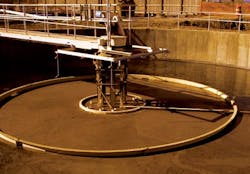But what has changed are conditions surrounding operations, especially the current global economics plus an aging workforce having few trained replacements, Ballina explains. And that spawns the do-more-with-less practice. To him, that means optimizing systems and increasing efficiencies, and thus productivity.Rebecca West sees and wrestles daily with these things. “We’ve seen smaller commercial businesses close. People have also reduced their water usage,” says West, director of technical services for Spartanburg (S.C.) Water (www.sws-sssd.org), a municipal water-and-wastewater function.She also notes that industrial wastewater dischargers may have cut back production or idled some operations. To offset this downturn, those dischargers request changes in their discharge permit limits, “for example, in the BOD (biochemical oxygen demand) and TSS (total suspended solids) loading,” West says. Industry payments based on these are common measures of water pollution, as well as volume of wastewater treated, she adds. “But they want some flexibility. Some are asking for [operating] variances [in what they can discharge] for a short time, to make those changes.”Easier integrationManaging asset-intensive water/wastewater treatment operations also challenges industries. Historically, companies have looked for ways to integrate maintenance/asset-management packages with supervisory-control-and-data-acquisition (SCADA) systems that respond to real-life conditions and allow easier flow of information between operations and maintenance, Ballina states. More recently, though, “object-based technology along with MIMOSA’s (Machinery Information Management Open Systems Alliance’s) open standards have opened the door for easier integration between SCADA and CMMS/EAM (computerized maintenance management system/enterprise asset management)-enabling condition-based monitoring.” These result in more efficient, optimized asset management.Regardless of how assets are managed, however, compliance drives operations. But the economy influences decisions and how regulators and the regulated relate. “We’ve worked closely with our industrial customers, in case they experience problems. We’ve been spending more time with them now,” West emphasizes. From that, she observes that one of industry’s biggest challenges appears to be switching to different products. “If pretreatment is a part of that, then that’s a whole other set of requirements.” Economics also drives preemptive action instead of reaction, West believes. “We’ve been proactive because we want to hang onto our commercial and industrial customers. Perhaps that means even helping them to decide how they can change their processes,” notes West, immediate past president of the Water Environment Federation (www.wef.org), Alexandria, Va. But difficulty comes, generally, “when you don’t sit down and talk through what you’re trying to accomplish,”she observes. One activity she encourages is recycling. West notes that some of her industrial customers now look at this cost reducer. But while less water provided or wastewater treated reduces costs, it means less money for utilities. “We’ve seen a sustained drop in revenue of 12 percent for the past year,” West remarks. That’s forced adjustments. “We’ve looked closely at our [treatment] chemical usage. On the water-supply side, we’ve changed operating times to match demands. With wastewater, with lower flows, we’re not spending as much in treatment costs. Primarily, though, we focused on the obvious: energy usage.”Because of the economy’s condition, “people are trying to find ways to make their processes more efficient,” West adds. “That’s given us an opportunity to work closer with our clients.” That’s a good thing, she says, something “we should fully leverage.” C. Kenna Amos, [email protected], is an Automation World Contributing Editor. Invensys Operations Managementwww.ips.invensys.comSpartanburg (S.C.) Waterwww.sws-sssd.orgWater Environment Federationwww.wef.org
Subscribe to Automation World's RSS Feeds for Columns & Departments
About the Author
C. Kenna Amos
Contributing Editor
Sign up for our eNewsletters
Get the latest news and updates

Leaders relevant to this article:
